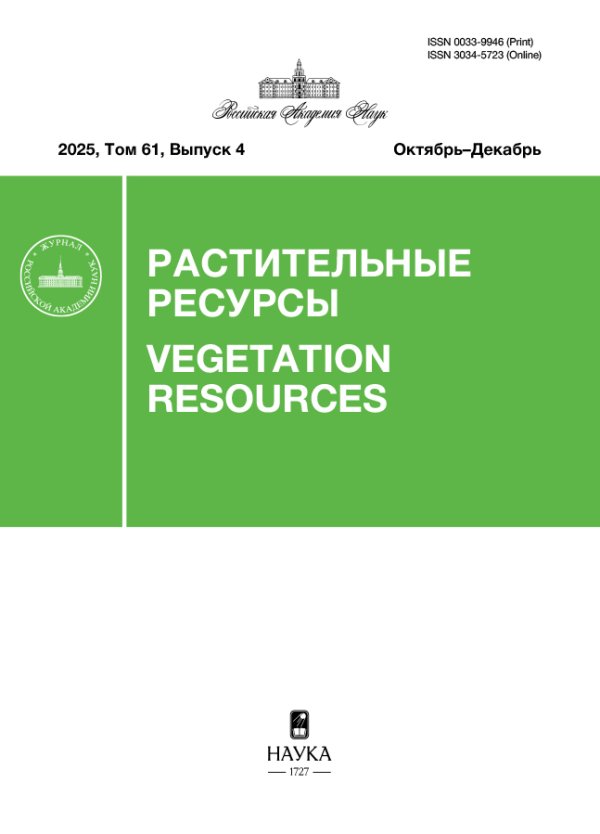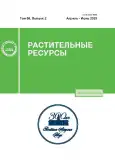Changes in the Individual and Group Composition of Polyphenols in Leaves of Lonicera caerulea subsp. altaica and Spiraea chamaedryfolia as Related to the Chemical Elements Content in Soil and Plants on the Ultra-Alkaline Parent Rock Material
- Authors: Boyarskykh I.G.1, Kostikova V.A.1
-
Affiliations:
- Central Siberian Botanical Garden SB RAS
- Issue: Vol 59, No 2 (2023)
- Pages: 164-179
- Section: Component Composition of Resource Species
- URL: https://journals.rcsi.science/0033-9946/article/view/138785
- DOI: https://doi.org/10.31857/S0033994623020048
- EDN: https://elibrary.ru/ZMQWQA
- ID: 138785
Cite item
Full Text
Abstract
Abstract
—A comparative analysis of the main classes of biologically active polyphenols in extracts from the leaves of the medicinal species Spiraea chamaedryfolia L. (Rosaceae) and Lonicera caerulea L. (Caprifoliaceae) was performed. The features related to the macro- and trace elements’ content in soil and phytomass in coenopopulations of the Mountain Altai at the site with sporadic occurrence of serpentinites were studied. In the S. chamaedryfolia leaves high performance liquid chromatography identified 16 polyphenolic compounds. These polyphenols were attributed to different classes, namely phenol-carboxylic acids (3), flavonols (10), flavons (2) and one flavanon. As for the L. caerulea leaves, the analysis confirmed their polyphenolic composition, measured earlier, i.e. the presence of hydroxycinnamic acids, flavonols and flavons; but additionally, one more compound, identified as flavanone, was found. The study revealed species-specific shifts in plant secondary metabolism in response to specific edaphic properties and the level of macro- and trace elements accumulation in the leaves of plants, growing in the area with a natural geochemical anomaly.
About the authors
I. G. Boyarskykh
Central Siberian Botanical Garden SB RAS
Author for correspondence.
Email: irina_2302@mail.ru
Russia, Novosibirsk
V. A. Kostikova
Central Siberian Botanical Garden SB RAS
Email: irina_2302@mail.ru
Russia, Novosibirsk
References
- Brunetti C., Fini A., Sebastiani F., Gori A., Tattini M. 2018. Modulation of phytohormone signaling: A primary function of flavonoids in plant–environment interactions. – Front. Pl. Sci. 9: 1042. https://doi.org/10.3389/fpls.2018.01042
- Bautista I., Boscaiu M., Lidón A. Llinares J.V., Lull C., Donat M.P., Mayoral O., Vicente O. 2016. Environmentally induced changes in antioxidant phenolic compounds levels in wild plants. – Acta Physiol. Plant. 38(1): 9. https://doi.org/10.1007/s11738-015-2025-2
- Michalak A. 2006. Phenolic compounds and their antioxidant activity in plants growing under heavy metal stress. – Pol. J. Environ. Stud. 15(4): 523–530. http://www.pjoes.com/pdf-87899-21758?filename=Phenolic%20Compounds%20and.pdf
- Kumarathilaka P., Dissanayake C., Vithanage M. 2014. Geochemistry of serpentinite soils: A brief overview. – J. Geol. Soc. Sri Lanka. 16: 53–63. http://viduketha.nsf.gov.lk:8585/slsijn/JGSSL-VOL-16-2014/JGSSL-VOL-16-2014-53.pdf
- Marescotti P., Comodi P., Crispini L., Gigli L., Zucchini A., Fornasaro S. 2019. Potentially toxic elements in ultramafic soils: A study from metamorphic ophiolites of the Voltri Massif (Western Alps, Italy). – Minerals. 9(8): 502. https://doi.org/10.3390/min9080502
- Кabata-Pendias A. 2010. Trace Elements in soils and plants. 4th ed. Boca Raton. 548 p. https://doi.org/10.1201/b10158
- Lovkova M.Ya., Rabinovich A.M., Ponomareva S.M., Buzuk G.N., Sokolova S.M. 2021. [Why do plants cure?]. Moscow. 256 p. (in Russian)
- Lovkova M.Ya., Sokolova S.M., Buzuk G.N., Bykhovskij V.Ya., Ponomareva S.M. 1999. Features of the elemental composition of medicinal plants synthesizing phenolic compounds. – Applied Biochemistry and Microbiology. 35(5): 514–524.
- Szymański M., Witkowska-Banaszczak E., Klak N., Marciniak K., Wołowiec T., Szymański A. 2014. Effects of trace Elements on polyphenoliccompounds in Millefoliiherba. – Pol. J. Environ. Stud. 23(2): 459–466. http://www.pjoes.com/pdf-89214-23073?filename=Effects%20of%20Trace%20Elements.pdf
- Boyarskih I.G., Syso A.I., Siromlya T.I. 2019. Variability of chemical elements and biologically active polyphenols in Lonicera caerulea subsp. altaica (Caprifoliaceae) plant organs along an altitudinal gradient. – Contemporary Problems of Ecology. 12(6): 594–606. https://doi.org/10.1134/S1995425519060039
- Krasteva I., Nedelcheva A., Pavlova D., Zdraveva P., Nikolov S., Mitov K. 2013. Influence of serpentine soils on the flavonoid content of Hypericum populations growing in Bulgaria. – Afr. J. Pharm. Pharmacol. 7(25): 1762–1765. https://doi.org/10.5897/AJPP2013.3634
- Sharma A., Lee H.-J. 2021. Lonicera caerulea: An updated account of its phytoconstituents and health-promoting activities. – Trends Food Sci. Technol. 107: 130–149. https://doi.org/10.1016/j.tifs.2020.08.013
- Boyarskih I.G., Vasiliev V.G., Kukushkina T.A. 2014. The content of flavonoids and hydroxycinnamic acids in Lonicera caerulea (Caprifoliaceae) from the populations of the Altai Mountains. – Rastitelnye Resursy. 50(1): 105–121. https://www.elibrary.ru/item.asp?id=21056295 (In Russian)
- Boyarskikh I.G., Syso A.I., Siromlya T.I. 2018. Mineral composition of Lonicera caerulea phytomass in contrasting geochemical environments. – Khimija Rastitel’nogo Syr’ja. 3: 129–138. https://doi.org/10.14258/jcprm.2018033740 (In Russian)
- Gołba M., Sokól-Lętowska A., Kucharska A.Z. 2020. Health properties and composition of honeysuckle berry Lonicera caerulea L. An update on recent studies. – Molecules. 25(3): 749. https://doi.org/10.3390/molecules25030749
- Jurikova T., Rop O., Mlcek J., Sochor J., Balla S., Szekeres L., Hegedusova A., Hubalek J., Adam V., Kizek R. 2012. Phenolic profile of edible honeysuckle berries (genus Lonicera) and their biological effects. – Molecules. 17(1): 61–79. https://doi.org/10.3390/molecules17010061
- Minayeva V.G. 1991. [Medicinal plants of Siberia]. Novosibirsk. 427 p. (in Russian).
- Kostikova V.A., Petrova N.V. 2021. Phytoconstituents and bioactivity of plants of the genus Spiraea L. (Rosaceae): A review. – Int. J. Mol. Sci. 22(20): 11163. https://doi.org/10.3390/ijms222011163
- Karpova E.A., Khramova E.P. 2019. Dinamics of pfenolic composition and content of representatives of the genus Spiraea L. under the conditions of transport and industrial pollution in Novosibirsk. – Chemistry for Sustainable Development. 27: 154–165. https://doi.org/10.15372/CSD2019123
- Kiss T., Cank K.B., Orbán-Gyapai O., Liktor-Bus E., Zomborszki Z.P., Rutkovska S., Pučka I., Németh A., Csupor D. 2017. Phytochemical and pharmacological investigation of Spiraea chamaedryfolia: A contribution to the chemotaxonomy of Spiraea genus. – BMC Res. Notes. 10(1): 762. https://doi.org/10.1186/s13104-017-3013-y
- Kiss T. 2017. Phytochemical, Pharmacological and Toxicological studies of alkaloid-and sesquiterpene lactone-containing medicinal plants. – Ph.D. Thesis, University of Szeged, Szeged, Hungary. 66 p. https://doktori.bibl.u-szeged.hu/id/eprint/4083/1/kiss-tivadar-PhD-Thesis.pdf
- Kostikova V.A., Filippova E.I., Vysochina G.I., Mazurkova N.A. 2016. [Antiviral activity of the Spiraea (Rosaceae) species growing in the Asian part of Russia]. – In: [Preservation of plant diversity in botanical gardens: traditions, present state, prospects. Proc. of the Int. conf. dedicated to the 70th anniversary of the Central Siberian Botanical Garden]. Novosibirsk. P. 156–157. http://conf.nsc.ru/files/conferences/csbg2016/343663/ЦСБС_СО_РАН_материалы.pdf (In Russian)
- Boyarskykh I.G., Siromlya T.I. 2022. Macro- and trace elements composition of the blue honeysuckle and elm-leaf spirea cenopopulations in the geochemically abnormal environment in the Mountain Altai. – Khimija Rastitel’nogo Syr’ja. 4: 211–220. (In Russian). https://doi.org/10.14258/jcprm.20220411294
- Kuminova A.V. 1960. [Vegetation cover of Altai]. Novosibirsk. 456 p. (in Russian)
- [State Geological Map of the Russian Federation. The 1 : 200 000. 2nd ed., Ser. Gorno-Altaisk. Sheet M-45-XIV (Ust-Koksa). Explanatory note] 2019. Moscow. 272 p. http://geo.mfvsegei.ru/200k/Zap/Zap_M-45-XIV.pdf (In Russian)
- Zaprometov M.N. 1974. [Fundamentals of biochemistry of phenolic compounds: textbook]. Moscow. 1974. (In Russian)
- Klyshev L.K., Bandyukova V.A., Alyukina L.S. 1978. [Plant flavonoids]. Alma-Ata. 220 p. (in Russian)
- Glantz S.A. 2012. Primer of Biostatistics. 7th ed. New York. 320 p. https://accessbiomedicalscience.mhmedical.com/book.aspx?bookid=665
- Arzhanova V.S., Elpatyevsky P.V. 1990. [Geochemistry of landscapes and technogenesis]. Moscow.196 p. (In Russian).
- Bityutskiy N.P. 2020. [Microelements of Higher Plants]. St. Petersburg. 368 p. (In Russian)
- Alexeeva-Popova N.V., Drozdova I.V. 2013. Micronutrient composition of the Polar Urals under contrasting geochemical conditions. – Russ. J. Ecol. 44(2): 100–107. https://doi.org/10.1134/S1067413613020033
- Skvortsov A.K., Kuklina A.G. 2002. [Blue honeysuckle: Botanical study and cultural perspectives in Central Russia]. Moscow. (In Russian)
Supplementary files













